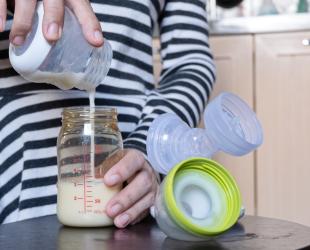Practical help for carers to keep feeds calm and comforting

Looking after a baby can feel a bit uncertain at first. This guide will help you feel confident feeding a breastfed baby with expressed milk and soothing them until Mum returns.
Understanding breastmilk and breastfed babies
- Breastmilk is the normal food for babies. It may look different to cow’s milk or formula and can separate into layers when it sits. That’s normal. Gently swirl the milk to mix it again.
- Amounts can vary. Breastfed babies often take smaller, varying amounts at each feed. Be guided by Mum’s plan and by baby’s cues.
How you can support Mum
Your positive attitude towards expressed breastmilk makes a big difference. Some mums find expressing easy; others put in real effort because it matters to them. If she visits to feed at your home or centre, baby often settles more quickly. If baby has a few fussy days and seems to need more, let Mum know so she can send extra milk; these phases usually pass within a few days. Your support helps her continue breastfeeding.
Preparing feeds
It’s important to follow safe steps when storing, warming and serving expressed milk. See Preparing expressed breastmilk for clear instructions.
Helping baby get started
- If possible, meet baby a few times (including a feed time) before you’re the caregiver. Familiarity helps.
- If you’re the only person who offers the bottle, baby often learns to accept it more easily.
- Some babies need time to get used to a teat. It feels and tastes different from Mum’s skin. Find practical tips on helping baby take a bottle.
If baby refuses to drink from a bottle, try these gentle options:
- Offer milk in a small cup. You could remove the teat and use the bottle as a cup. Hold baby upright and start with small sips.
- Older babies may do well with a straw or sipper cup.
- Gentle rocking or walking can help baby settle enough to feed.
- A familiar scent can soothe. If Mum leaves a clean item of clothing, baby may cuddle into it while feeding.
Paced bottle feeds
Breastfed babies are used to controlling the milk flow as they feed. A fast flow teat can be stressful. If your baby is gulping or swallowing quickly, it may be their way of coping with the flow, not a sign they're hungry. Paced bottle feeding helps babies manage the flow and stay comfortable.
Settling a breastfed baby
Many breastfed babies are used to being cuddled or rocked to sleep. Fast, gentle back-patting with slow side-to-side movement can soothe. Using a baby carrier may also help. Keep baby high and close enough that you could easily kiss their head.
When Mum is returning soon
If baby becomes unsettled, try holding them and speaking softly. A small amount of expressed milk in a clean bottle, small cup or on a spoon can help keep baby calm until Mum arrives. Many mums like to feed as soon as they return. It’s comfortable for them and supports milk supply.
If you’re running out of milk
Give baby the last of the expressed milk. If they still need more before Mum returns, contact her first before offering anything else (even water). She may be able to come earlier or send extra milk. If baby is eating other foods, only offer foods they’ve had before, and check with Mum first.
Need more help?
Contact Mum if you need urgent information about feeding her baby. Call the Breastfeeding Helpline if you have questions about storing, preparing or feed a baby expressed breastmilk.
Handy resource to share
The Carer’s guide to the breastfed baby is a downloadable leaflet with tips for storing, preparing and feeding expressed milk — perfect to give to anyone caring for your baby. Access and download this leaflet now.




